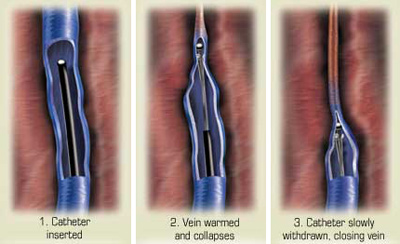- Successful treatment depends on careful pre-operative assessment.
- No two peoples’ varicose veins are the same and the right procedure for one person may not be successful for someone else.
What does VNUS closure technique involve?
The VNUS Closure Technique is a minimally invasive way of treating varicose veins. With this technique, a special catheter (a closure catheter) is positioned into the varicose vein through a very small incision in the skin. The catheter delivers radiofrequency energy to the wall of the varicose vein. As the catheter is withdrawn, the vein wall is heated causing the vein to close. Once the varicose vein has closed, the blood is redirected to the healthy veins (see picture).
What happens to the varicose vein once it has been treated with the VNUS closure?
The vein breaks down and is reabsorbed by the body.
Can the VNUS closure technique be performed under both local and general anaesthetic?
Yes. This technique can be performed under either local or general anaesthetic depending on preference.
How uncomfortable is the local anaesthetic option?
If you opt for local anaesthetic, a series of injections are needed during the operation. But usually patients do not feel these after the first few.
Does the VNUS closure technique involve staying in hospital?
For the majority of procedures, both local and general anaesthetic procedures are performed as day-cases. Occasionally patients opt to stay overnight and this can be arranged if necessary.
What are the advantages of this technique compared to traditional varicose vein surgery?
With VNUS Closure, stripping of the vein is avoided. This technique is associated with less post-operative pain and bruising and a quick return to normal activity. It is also associated with minimal or no scarring.
What potential complications may occur with the VNUS closure technique?
Potential complications include phlebitis, haematoma, infection, skin burns, paraesthesia and thrombosis.
How painful is the VNUS closure technique?
Most patients find they need to take painkillers for only a few days after the operation.
Will my legs be bandaged after the operation?
Yes. The legs are bandaged in the operating theatre and are worn for two days. They are removed at home and replaced by compression stockings which are then worn for two weeks. You will be measured in hospital for the correct size of stockings, which should be worn during the daytime but can be taken off at night.
What follow up is required?
Outpatient follow up is arranged six to eight weeks after the operation to assess the effects of the treatment. Quite often no further intervention is required, but sometimes residual varicose veins do require treatment with injection sclerotherapy. Additionally, VNUS closure does not treat thread veins and treatment of these has to be performed in clinic once the legs have recovered from the surgery. Again, this is done with simple injection sclerotherapy over several weeks.
How long will I need to be off work after VNUS closure surgery?
Patients vary in the time to return to work, ranging from the next day to a few weeks, depending on the extent of the procedure, pre-existing medical conditions and the type of work.
How mobile will I be after the surgery?
Patients can walk around immediately after the operation and walking is encouraged post-operatively. Normal activities can resume very quickly.
When can I drive after VNUS closure surgery?
It is recommended that you do not drive until you are pain free and in full control of the vehicle – usually around seven days.
When can I return to the gym or start heavier exercise after VNUS closure surgery?
As a general rule, it is recommended that heavy exercise be avoided for about four weeks while healing occurs.
When can I fly after VNUS closure surgery?
We recommended six weeks long haul or four weeks if it is a short haul flight.
Can veins come back after VNUS closure surgery?
Yes they can, but figures suggest that reoccurrence is less common than after traditional varicose vein surgery.








